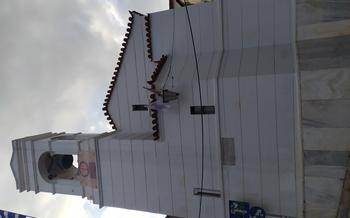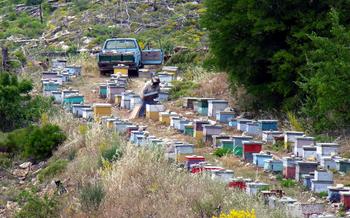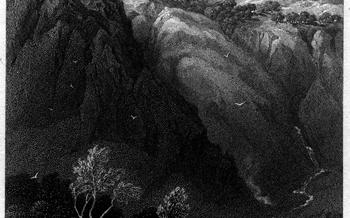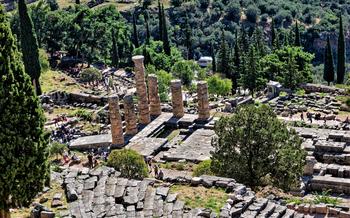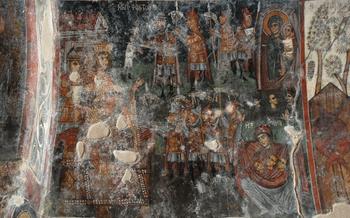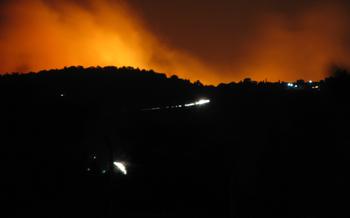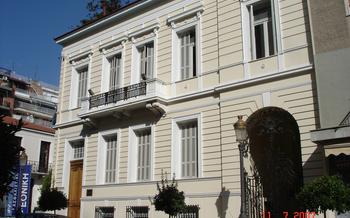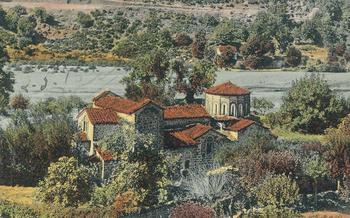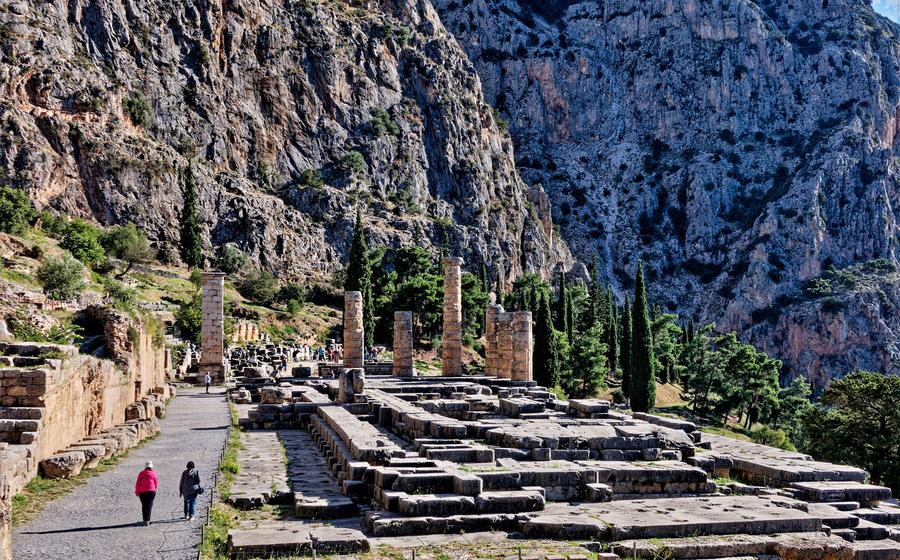
The Monastery of Prophet Elias
- Historical Significance
- Breathtaking Views
- Hiking Trails to the Monastery of Prophet Elias: A Journey of Nature and Spirituality
- Pilgrimage Experience
- Monastery Architecture
- Religious Artifacts
- Local Cuisine
- Festivals and Events
- Accommodation
- Getting There
- Visiting Hours
- Dress Code
- Pilgrimage Tips
- Photography Guidelines
- Insider Tip: The Hidden Panorama
Historical Significance
Nestled amidst the mountainous landscapes of Greece, the Monastery of Prophet Elias stands as a testament to the country's rich history and deep religious traditions. Founded in the 16th century by a group of devout monks, the monastery has served as a spiritual and cultural beacon for centuries. Its strategic location atop Mount Parnassus, overlooking the picturesque town of Delphi, further enhances its allure, attracting numerous pilgrims and visitors seeking spiritual enlightenment and historical exploration.
The monastery's architectural style reflects the Byzantine influence prevalent in Greek Orthodox architecture. Its whitewashed walls, intricate domes, and arched walkways create a harmonious blend of simplicity and elegance. Inside, visitors marvel at the exquisite frescoes and mosaics that adorn the walls and ceilings, depicting biblical scenes and the life of Prophet Elias, the monastery's namesake. These artistic treasures not only add to the monastery's aesthetic appeal but also serve as a testament to the skill and devotion of the monks who created them.
The monastery's significance extends beyond its architectural and historical value. It holds a deep spiritual connection to Greek Orthodox Christianity, serving as a popular pilgrimage site for believers from all over the country. Pilgrims flock to the monastery to pay homage to the relics of Prophet Elias, believed to possess miraculous healing powers. They participate in religious rituals, offer prayers, and seek solace and guidance within the monastery's sacred walls.
Breathtaking Views
The Monastery of Prophet Elias is not just a religious site, but also a natural wonder. Perched atop a hill, it offers visitors breathtaking panoramic views of the surrounding landscape. From the monastery's terraces and balconies, visitors can gaze out at the verdant valleys, the majestic mountains, and the sparkling Gulf of Corinth. The monastery is a popular spot for photography and nature enthusiasts, who come to capture the stunning vistas and the ever-changing play of light and shadow. Whether you're a pilgrim seeking spiritual solace or a traveler in search of breathtaking scenery, the Monastery of Prophet Elias is sure to leave you awestruck.
Hiking Trails to the Monastery of Prophet Elias: A Journey of Nature and Spirituality
For those who seek a more immersive and adventurous experience, the Monastery of Prophet Elias can be reached via various hiking trails that wind through the picturesque landscapes of Delphi. These trails offer a unique opportunity to combine physical activity with spiritual introspection, as hikers traverse ancient pathways once trodden by pilgrims and monks.
Difficulty levels range from easy, suitable for families with young children, to moderate and challenging, catering to experienced hikers. Trail distances vary from a leisurely 2 kilometers to more strenuous 10-kilometer routes, with estimated hiking times ranging from one to three hours.
The best time to embark on these hikes is during the cooler months, from September to May, when temperatures are pleasant for outdoor activities. Hikers are advised to carry sufficient water, wear comfortable footwear, and be prepared for uneven terrain and occasional wildlife encounters.
Along the way, hikers will be rewarded with breathtaking views of the surrounding mountains, valleys, and the shimmering Gulf of Corinth. The trails offer ample opportunities to pause, soak in the natural beauty, and reflect on the spiritual significance of the journey.
Pilgrimage Experience
For many faithful Orthodox Christians, the Monastery of Prophet Elias holds deep spiritual significance as a pilgrimage site. Pilgrims from all over Greece and beyond flock to the monastery, seeking spiritual renewal and connection with their faith. The monastery offers a rich and immersive pilgrimage experience, allowing visitors to immerse themselves in the traditions and rituals of Greek Orthodox Christianity.
Pilgrims can participate in daily church services, light candles, and pray at the monastery's many shrines and icons. They can also receive blessings from the monks and attend spiritual talks and lectures. The monastery's peaceful and serene atmosphere fosters a sense of contemplation and introspection, making it an ideal place for pilgrims to seek solace and guidance.
One of the most important rituals associated with the pilgrimage to the Monastery of Prophet Elias is the veneration of the monastery's relics. These relics, which include bones, clothing, and other personal items of saints and martyrs, are believed to possess miraculous powers. Pilgrims often touch or kiss the relics, seeking healing, protection, and spiritual guidance.
The monastery also hosts several annual festivals and celebrations, which attract large numbers of pilgrims. These festivals feature processions, chanting, and other religious rituals, as well as traditional Greek music, dance, and food. Pilgrims can join in the festivities and experience the vibrant and joyous atmosphere of these celebrations.
Monastery Architecture
The Monastery of Prophet Elias boasts an impressive architectural ensemble that reflects the rich history and religious significance of the site. The monastery complex comprises several churches, bell towers, and courtyards, each showcasing unique features and artistic elements.
The main church, dedicated to the Prophet Elias, is a testament to Byzantine architectural prowess. Its domed roof, intricate frescoes depicting biblical scenes, and ornate iconostasis create a sense of awe and reverence. The bell towers, with their distinctive pointed spires, rise majestically above the monastery, echoing the call to prayer across the surrounding hills.
Within the monastery walls, visitors can explore the serene courtyards, adorned with lush gardens, fountains, and arched walkways. These tranquil spaces provide a sanctuary for reflection and contemplation, inviting visitors to immerse themselves in the spiritual atmosphere of the monastery.
The monastery's architectural heritage is further enriched by the presence of valuable frescoes and mosaics. These exquisite works of art depict religious figures, biblical narratives, and scenes from the life of Prophet Elias. The vibrant colors and intricate details of these artworks bring the stories of the Bible to life, creating a visual feast for visitors to admire.
The architectural style of the Monastery of Prophet Elias is a harmonious blend of Byzantine, Ottoman, and traditional Greek elements. The monastery's construction and design reflect the diverse cultural influences that have shaped Greece throughout history.
Religious Artifacts
The Monastery of Prophet Elias houses a treasure trove of significant religious artifacts and relics that hold immense historical and spiritual importance for the Orthodox Christian faith. Among these sacred items, visitors can marvel at the beautifully preserved icon of the Prophet Elias, which is believed to date back to the early Byzantine era. This iconic representation of the prophet is adorned with intricate gold leaf and precious gems, exuding a sense of divine presence.
Another notable artifact is the reliquary containing a fragment of the Prophet Elias's cloak. This relic is revered by pilgrims as a tangible connection to the biblical figure, and it is believed to possess miraculous healing powers. Visitors can also witness the ancient manuscript collection, which includes rare and priceless religious texts that offer a glimpse into the monastery's rich history and spiritual traditions.
Finally, the monastery's ornate silver cross, crafted by skilled artisans during the 18th century, stands as a testament to the monastery's artistic heritage. This exquisite cross is a symbol of faith and devotion, and it is often used in religious ceremonies and processions.
Local Cuisine
The Monastery of Prophet Elias is not only a spiritual haven but also a culinary delight. The monastery's kitchen is renowned for preserving and promoting traditional Greek cuisine, using fresh, locally sourced ingredients to create mouthwatering dishes that reflect the rich culinary heritage of the region. Visitors can savor a variety of traditional Greek dishes, including hearty stews, flavorful grilled meats, fresh salads, and delectable pastries.
One of the must-try dishes at the monastery is the traditional Greek salad, prepared with ripe tomatoes, crisp cucumbers, sweet onions, and tangy feta cheese, all drizzled with a generous helping of extra virgin olive oil. Another popular dish is moussaka, a flavorful casserole made with layers of eggplant, potatoes, and minced meat, topped with a creamy béchamel sauce. For a taste of the sea, visitors can indulge in grilled octopus, tender and succulent, served with a zesty lemon-oregano dressing.
The monastery's bakers also work their magic, creating an array of tempting pastries and sweets. Visitors can choose from baklava, a filo pastry filled with chopped nuts and sweetened with honey syrup; loukoumades, delicious fried dough balls drizzled with honey and cinnamon; and galaktoboureko, a custard pie topped with phyllo dough and sprinkled with powdered sugar.
Whether visitors are seeking a quick bite or a leisurely meal, the Monastery of Prophet Elias offers a culinary experience that is both authentic and delicious. The monastery's dining facilities provide a warm and inviting atmosphere, where visitors can savor the flavors of traditional Greek cuisine while immersing themselves in the monastery's spiritual ambiance.
Festivals and Events
The Monastery of Prophet Elias is not just a place of religious significance but also a vibrant hub of cultural and community events. Throughout the year, the monastery plays host to a variety of festivals and religious celebrations that draw pilgrims and visitors from near and far.
One of the most prominent festivals is the annual celebration of Prophet Elias' feast day, which takes place on July 20th. This grand event features a solemn religious service, followed by traditional Greek music, dancing, and feasting. Pilgrims and visitors can immerse themselves in the festive atmosphere, savor delicious local delicacies, and witness the vibrant cultural traditions of the region.
Another notable event is the Holy Week procession, which takes place during the week leading up to Easter. During this sacred period, the monastery's monks and pilgrims participate in a solemn procession, carrying religious icons and relics through the picturesque surroundings of the monastery. The procession is a moving testament to the deep faith and devotion of the Orthodox Christian community.
These festivals and events offer a unique opportunity for visitors to experience the rich spiritual and cultural heritage of the Monastery of Prophet Elias. By participating in these celebrations, visitors can gain a deeper understanding of the monastery's significance and its role in the lives of the local community.
Accommodation
For a truly immersive experience, consider staying overnight near the Monastery of Prophet Elias. Several charming guesthouses and hotels in the surrounding area offer comfortable accommodations and breathtaking views. The traditional Greek hospitality and delectable local cuisine will enhance your pilgrimage journey.
The Prophet Elias Hotel, situated just a short walk from the monastery, offers panoramic views of the surrounding mountains and the Gulf of Corinth. Its elegant rooms are adorned with traditional Greek décor, and guests can savor delicious regional dishes at the on-site restaurant.
For a more rustic experience, opt for the Monastery Guesthouse. Located within the monastery grounds, it provides simple yet comfortable rooms for pilgrims and visitors. The guesthouse offers a unique opportunity to immerse oneself in the monastery's spiritual atmosphere and connect with fellow pilgrims.
Alternatively, the nearby village of Arachova boasts a range of hotels and guesthouses that cater to pilgrims and tourists alike. From traditional Greek tavernas to modern hotels, there's something to suit every budget and preference.
Getting There
Reaching the Monastery of Prophet Elias is a journey that blends scenic landscapes with spiritual exploration. To get there, you can embark on a picturesque drive, following winding roads that lead through quaint villages and verdant valleys. For those who prefer public transportation, buses and trains connect major cities in Greece to nearby towns, from where you can take a short taxi or bus ride to the monastery.
If you're an adventurous traveler, hiking trails offer a rewarding way to reach the monastery. These trails traverse stunning mountain terrain, offering panoramic vistas and the chance to immerse yourself in nature's tranquility. Remember to wear comfortable shoes, carry water, and plan your hike accordingly, as some trails may take several hours to complete.
Whether you choose to drive, take public transportation, or embark on a hike, the journey to the Monastery of Prophet Elias is an experience in itself. Along the way, you'll be greeted by the warmth of local hospitality and the beauty of the Greek countryside, setting the stage for an unforgettable pilgrimage.
Visiting Hours
The Monastery of Prophet Elias welcomes visitors daily, offering a serene and spiritual atmosphere for contemplation and exploration. The monastery's visiting hours are generally from 8:00 AM to 5:00 PM, allowing ample time for visitors to wander through its courtyards, admire its architecture, and connect with the tranquil surroundings.
It is recommended to visit the monastery during the morning hours, when the natural light illuminates the monastery's features and creates a magical ambiance. During this time, the monastery is typically less crowded, providing a peaceful and intimate experience for visitors.
On certain holidays or special events, the monastery's visiting hours may vary. It is advisable to check the monastery's official website or contact the local tourism office for the most up-to-date information on visiting hours and any special restrictions or closures.
When planning your visit, keep in mind that the monastery is a sacred place of worship for Orthodox Christians. Visitors are kindly requested to be respectful and mindful of ongoing religious services and ceremonies. Silence and appropriate behavior are expected within the monastery's grounds.
Dress Code
When visiting the Monastery of Prophet Elias, it is essential to dress respectfully, adhering to the Orthodox Christian customs and traditions. This means avoiding revealing or overly casual clothing. For women, it is recommended to wear a long skirt or dress that covers the knees, along with a blouse or top that covers the shoulders. Men should wear long pants and a collared shirt. Shorts, tank tops, and other revealing attire are not permitted. Visitors should also avoid wearing hats or sunglasses inside the monastery churches. By dressing appropriately, visitors demonstrate their respect for the sacredness of the site and the religious beliefs of the monks and pilgrims.
Pilgrimage Tips
For pilgrims planning a visit to the Monastery of Prophet Elias, here are some practical tips to ensure a smooth and enriching experience:
-
Plan Ahead: Before your visit, research the monastery's history, pilgrimage traditions, and any special events or services that may be taking place during your stay. This will help you make the most of your time at the monastery.
-
Dress Appropriately: Remember that the monastery is a sacred place of worship. Dress respectfully and modestly, covering your shoulders and knees. Avoid wearing shorts, tank tops, or revealing clothing.
-
Bring Essentials: Pack comfortable shoes for walking on uneven terrain. Carry a water bottle, as there are limited water sources within the monastery. A camera is also recommended to capture the stunning views and architectural details.
-
Be Mindful of Silence: The monastery is a place of contemplation and prayer. Be mindful of your noise level and avoid disturbing other pilgrims. Silence your phone and speak softly when conversing with others.
-
Respect Local Customs: Familiarize yourself with Greek Orthodox customs and traditions. When entering the monastery, greet the monks or priests with a respectful bow or nod. Follow any specific instructions or guidelines given by the monastery staff.
-
Plan Your Stay: If you wish to stay overnight, book your accommodation in advance, especially during peak pilgrimage seasons. Limited lodging options are available near the monastery, so early reservations are recommended.
Photography Guidelines
Photography enthusiasts are welcome to capture the beauty of the Monastery of Prophet Elias, but certain guidelines must be followed to ensure respect for the sacred nature of the site. Photography is permitted in most areas of the monastery, including the courtyards, gardens, and exterior facades of the churches. However, it is strictly prohibited inside the churches themselves, where silence and reverence are maintained.
When taking photos, visitors should be mindful of other pilgrims and avoid disturbing their prayers or meditation. Using flash photography is not allowed inside the monastery, as it can be disruptive and disrespectful. Additionally, visitors should refrain from taking photos of individuals without their consent.
By following these photography guidelines, visitors can contribute to preserving the sanctity of the monastery while capturing its unique beauty and spiritual atmosphere.
Insider Tip: The Hidden Panorama
Venture beyond the main courtyard and ascend the narrow stone steps that lead to the monastery's hidden gem – a secluded terrace overlooking a breathtaking panorama. Here, visitors are greeted with an unparalleled vista that extends far beyond the monastery walls. The majestic mountains, verdant valleys, and the shimmering Gulf of Corinth converge in a mesmerizing tapestry of natural beauty. As the sun dips below the horizon, the sky transforms into a canvas of vibrant hues, creating a truly unforgettable spectacle. This secret spot offers a moment of tranquility and awe, allowing visitors to connect with the divine and appreciate the wonders of creation.
